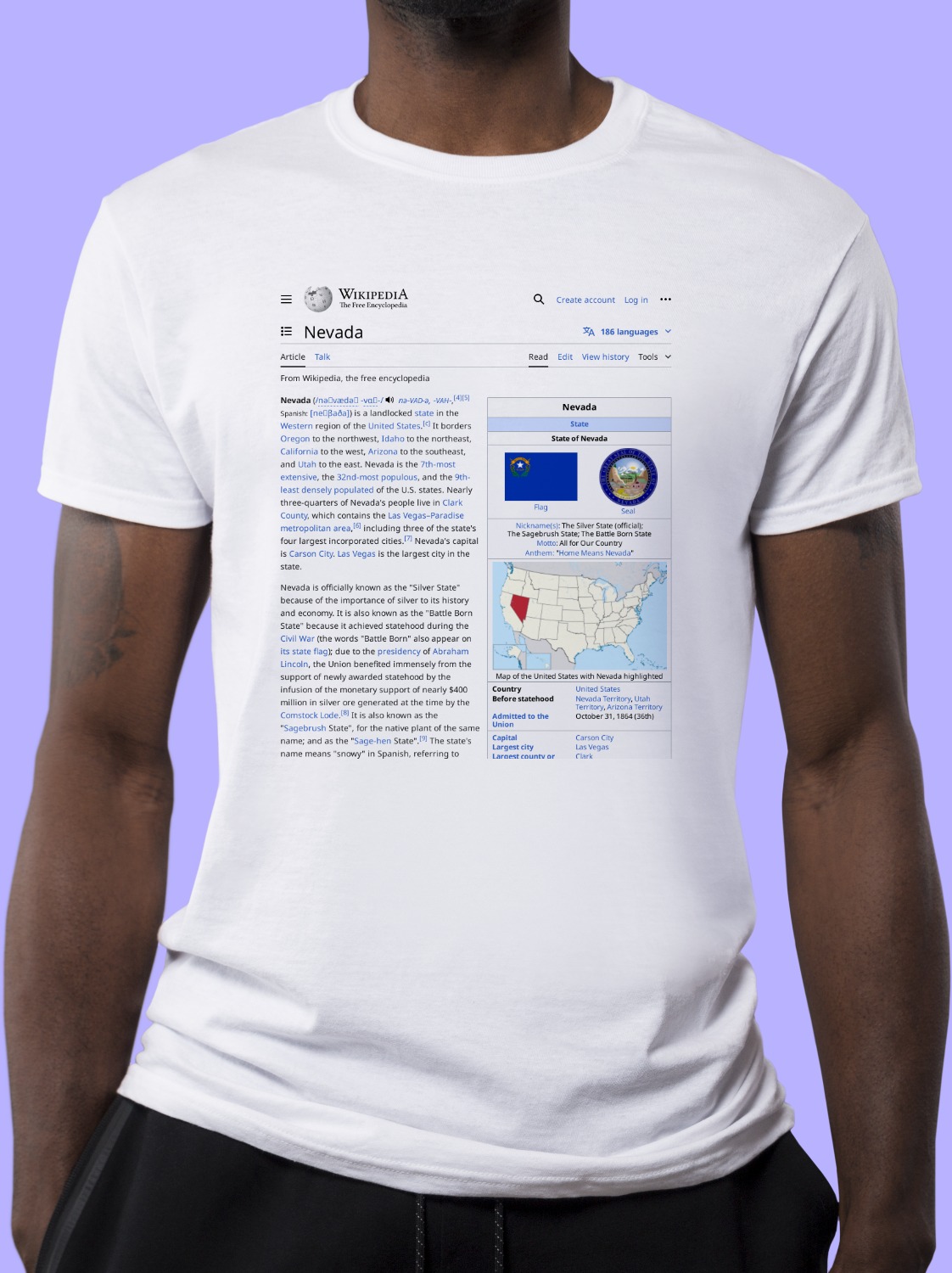
Nevada Shirt
A classic cotton tee emblazoned with the Wikipedia article on Nevada ↗.
cotton tee emblazoned with the Wikipedia article on Nevada ↗.- Preshrunk jersey knit
- Seamless double-needle 2.2 cm collar
- Taped neck and shoulders
- Tear away label
- Double-needle sleeve and bottom hems
- Quarter-turned to eliminate centre crease
Nevada ( nə-VAD-ə; Spanish: [neˈβaða] ) is a state in the Western United States. It is also sometimes placed in the Mountain West and Southwestern United States. It borders Oregon to the northwest, Idaho to the northeast, California to the west, Arizona to the southeast, and Utah to the east. Nevada is the seventh-most extensive and the 32nd-most populous U.S. state. Nearly three-quarters of Nevada's population live in Clark County, which contains the Las Vegas–Paradise metropolitan area. Nevada's capital is Carson City. Las Vegas is the largest city in the state.
Nevada is officially known as the "Silver State" because of the importance of silver to its history and economy. It is also known as the "Battle Born State" because it achieved statehood during the Civil War; as the "Sagebrush State", for the native plant of the same name; and as the "Sage-hen State". Native Americans of the Paiute, Shoshone, and Washoe tribes inhabit what is now Nevada. The first Europeans to explore the region were Spanish. They called the region Nevada (snowy) because of the snow which covered the mountains in winter, similar to the Sierra Nevada in Spain. The area formed from mostly Alta California and part of Nuevo México's territory within the Viceroyalty of New Spain, which gained independence as Mexico in 1821. The United States annexed the area in 1848 after its victory in the Mexican–American War, and it was incorporated as part of the New Mexico and Utah Territory in 1850. The discovery of silver at the Comstock Lode in 1859 led to a population boom that became an impetus to the creation of Nevada Territory out of western Utah Territory in 1861. Nevada became the 36th state on October 31, 1864, as the second of two states added to the Union during the Civil War (the first being West Virginia).
Nevada is known for its libertarian laws. In 1940, with a population of just over 110,000 people, Nevada was by far the least-populated state, with less than half the population of the next least-populous state, Wyoming. However, legalized gambling and lenient marriage and divorce laws transformed Nevada into a major tourist destination in the 20th century. Nevada is the only U.S. state where prostitution is legal, though it is illegal in its most populated regions – Clark County (Las Vegas), Washoe County (Reno) and Carson City (which, as an independent city, is not within the boundaries of any county). The tourism industry remains Nevada's largest employer, with mining continuing as a substantial sector of the economy: Nevada is the fourth-largest producer of gold in the world.
The state's name means "snowy" in Spanish, referring to Nevada's extensive number of mountain ranges capped with snow in winter, which help make Nevada among the highest US states by mean altitude. These include the Carson Range portion of the Sierra Nevada (and about 1/3 of Lake Tahoe by surface area), as well as the Toiyabe Range, Ruby Mountains, and Spring Mountains (which exemplify the sky islands of the Great Basin montane forests), in western, central, northeastern, and southern Nevada, respectively. Nevada is the driest U.S. state, both lying in the rain shadow of the Sierra Nevada and receiving among the highest solar irradiance of any U.S. state, and is thus largely desert and semi-arid. Nevada comprises the majority of the Great Basin, as well as a large portion of the Mojave Desert. In 2020, 80.1% of the state's land was managed by various jurisdictions of the U.S. federal government, both civilian and military. Droughts in Nevada, which are influenced by climate change, have been increasing in frequency and severity, putting a further strain on Nevada's water security. Nonetheless, Nevada is among the leaders in adapting to climate change, including via climate science at Desert Research Institute, extensive water recycling in the Las Vegas metropolitan area, voter-mandated investment in solar power, hosting leading electric vehicle manufacturing ecosystem resources at the largest industrial park in the U.S., and developing the largest lithium mine in the U.S. for use in electric batteries.
About Wikishirt
Wikishirt is a retail experiment that lets you buy a shirt with any Wikipedia Article printed on it. There are over 5 million Wikipedia articles, so we have over 5 million shirts.Check out our homepage for random featured shirts and more!